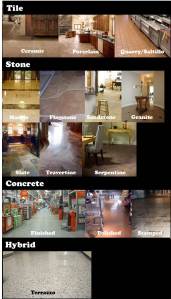Pre-Inspection Procedures for Restorative Cleaning of Stone, Tile, Grout, and Finished Concrete Flooring Surfaces
 After you have had the chance to carefully study, practice and understand how to identify the type of hard surface floor you are being asked to restoratively clean (see previous blog entries), it is time to consider the specific procedures necessary before you start the job itself. This is often referred to as the “pre-inspection” phase. Pre-inspection is the most important part of any restorative cleaning job. As the old adage goes, a problem identified during the pre-inspection process belongs to the customer. A problem revealed during the cleaning process itself belongs to you. During the pre- inspection process, there are five very important goals to accomplish:
After you have had the chance to carefully study, practice and understand how to identify the type of hard surface floor you are being asked to restoratively clean (see previous blog entries), it is time to consider the specific procedures necessary before you start the job itself. This is often referred to as the “pre-inspection” phase. Pre-inspection is the most important part of any restorative cleaning job. As the old adage goes, a problem identified during the pre-inspection process belongs to the customer. A problem revealed during the cleaning process itself belongs to you. During the pre- inspection process, there are five very important goals to accomplish:
- Evaluate the floor by identifying pre-existing conditions.
- Increase your chances for a successful outcome by under-promising and over-delivering.
- Recognize conditions that could be created or revealed during cleaning and keep them from become problems.
- Point out repairs and corrections and floor restoration that might need to be performed that exceeds the parameters of the restorative cleaning job that. This opens up additional income earning opportunities for your company or a referral partner you outsource these jobs to.
- To be sure your scope of work and pricing accurately reflects the work you will need to perform.
Pre-Inspection Guidelines
- The first thing to evaluate is the INTEGRITY of the floor and installation. Check for –
- Lippage or uneven installation of the floor with some of the tiles or stone being higher than others. Variations of 1/16” are acceptable.
- The only means of correcting lippage is to grind the affected tiles until they are all even. Lippage can not be corrected by cleaning procedures and in some cases, severe lippage may prevent you from being able to effectively clean the floor .
- Loose tiles or stone can be located by tapping the floor with a rubber mallet or a wooden handle. A hollow sound indicates the tile is not firmly attached to the underlayment. Record the number and location of any loose tiles.
- Note any cracked or damaged tile or stone.
- Look for missing, cracked and loose grout. This may come out during the cleaning process. Missing or damage grout can be repaired for an additional fee.
- Moisture underneath the tiles could indicate a serious problem.
- A moisture meter can be used to compare moisture levels before and after the job.
- Excess moisture indicates a leak or other source of water under the flooring and also an increased likelihood of efflorescence.
- Checking moisture levels also indicates when the floor has returned to normal moisture content and is ready for seal.
- Additional Pre-inspection procedures –
- Check for wax or topical coatings as discussed earlier. If there is a coating that needs
 to be removed, allow for the extra work in your schedule and pricing.
to be removed, allow for the extra work in your schedule and pricing. - Determine porosity of the stone or tile. A porous floor will require more preconditioner. The floor will absorb more water and require longer to dry.
- Porosity also influences the amount of sealer that must be applied. Apply less sealer than the floor will hold and you have not provided the most effective application. Apply more sealer than the floor will absorb and the excess will dry on the surface forming a milky, white haze.
- Look for signs of efflorescence – a precipitate that has the appearance of a white, chalky powder-like substance on the surface of the grout or stone or porous tiles such as saltillo.. Some efflorescence will look like crystals. This type is more difficult to remove.
- Scratches, abrasion and other indicators of wear are not removed by cleaning! This means a clean floor may not have the same level of gloss it once did.
- Abrasive wear is common in softer stone.
- Correcting scratches requires polishing which is a separate and additional service from cleaning.
- Check for wax or topical coatings as discussed earlier. If there is a coating that needs
- Your pre-inspection may reveal that a job poses potential problems beyond your experience or skill level. Know when to walk away from a job that could be unprofitable or holds risks you are not willing to accept.
- Preparation and Set-up
- Determine all areas that need to be prepared and protected prior to starting the cleaning job – Door ways, floor transition areas, stairwells, appliances, walls, furniture
- Always take into consideration any carpet or wood floors that are that adjoin the floor being cleaned. Protect with a double layer of plastic to prevent damage from overspray or splashes.
- CAUTION! Acid cleaners can permanently damage stainless steel. Keep any stainless stell appliance or fixture or brass fixture from coming in dirct contact with any acid cleaning solution you use on the job
- Review the steps necessary to do the job. An ounce of prevention prevents call-backs and damaged property!
- Make sure your customer has signed for and approved all the options you have discussed.
- Be realistic about extreme situations. Under-promise and over-deliver!
- Now you are ready to proceed to the cleaning job itself. Specific step by step procedures for cleaning stone, tile, and finished concrete can be downloaded by clicking here.
Tags: Finished Concrete, Grout, pre-inspection, preparation, restoration, stone, tile





